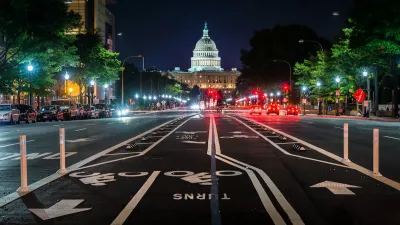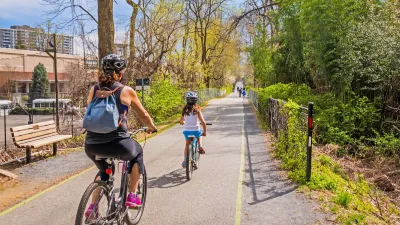Minor pedestrian-oriented improvements alone won't improve walkability if infrastructure still prioritizes fast-moving vehicles, according to this article.

Pedestrian infrastructure projects too often prioritize faster car traffic and fail to implement real protective measures for people walking, argues Joe Cortright. Houston's Energy Corridor, which recently received a high-profile "pedestrian makeover," provides a prime example of the "remedial and performative" projects that, according to Cortright, project the appearance of walkability while maintaining "an auto-dominated and pedestrian hostile environment." With 60,000 cars passing through every day, the newly renovated intersection, with its dangerous "slip lanes," offers minimal safety for pedestrians and cyclists. Aside from the lack of real protection for pedestrians, the area suffers from a lack of walkable destinations. "Pro-tip: any area that describes itself as a 'corridor' is almost always an auto-dominated, pedestrian-hostile space, a place people travel through, rather than being in."
Cortright points to similar examples in other cities, asserting that "much of what purports to be 'pedestrian' infrastructure, is really car infrastructure, and is only necessary in a world that’s dominated by car travel." True pedestrian infrastructure, he writes, includes density, walkable destinations, and fewer, slower cars. "Walkability and pedestrian safety are really about building great places, not piecemeal and largely decorative so-called infrastructure."
FULL STORY: More performative pedestrian infrastructure

Montreal Mall to Become 6,000 Housing Units
Place Versailles will be transformed into a mixed-use complex over the next 25 years.

Planetizen Federal Action Tracker
A weekly monitor of how Trump’s orders and actions are impacting planners and planning in America.

DARTSpace Platform Streamlines Dallas TOD Application Process
The Dallas transit agency hopes a shorter permitting timeline will boost transit-oriented development around rail stations.

Without International Immigrants, the Rural US Population Would Be Falling 58%
Census data shows that population growth in rural areas is due in large part to international migrants.

Dead End: Nine Highways Ready for Retirement
The Freeways Without Futures report describes the nation’s most promising highway removal proposals.

Congressman Proposes Bill to Rename DC Metro “Trump Train”
The Make Autorail Great Again Act would withhold federal funding to the system until the Washington Metropolitan Area Transit Authority (WMATA), rebrands as the Washington Metropolitan Authority for Greater Access (WMAGA).
Urban Design for Planners 1: Software Tools
This six-course series explores essential urban design concepts using open source software and equips planners with the tools they need to participate fully in the urban design process.
Planning for Universal Design
Learn the tools for implementing Universal Design in planning regulations.
City of Mt Shasta
City of Camden Redevelopment Agency
City of Astoria
Transportation Research & Education Center (TREC) at Portland State University
City of Camden Redevelopment Agency
Municipality of Princeton (NJ)
Regional Transportation Commission of Southern Nevada





























